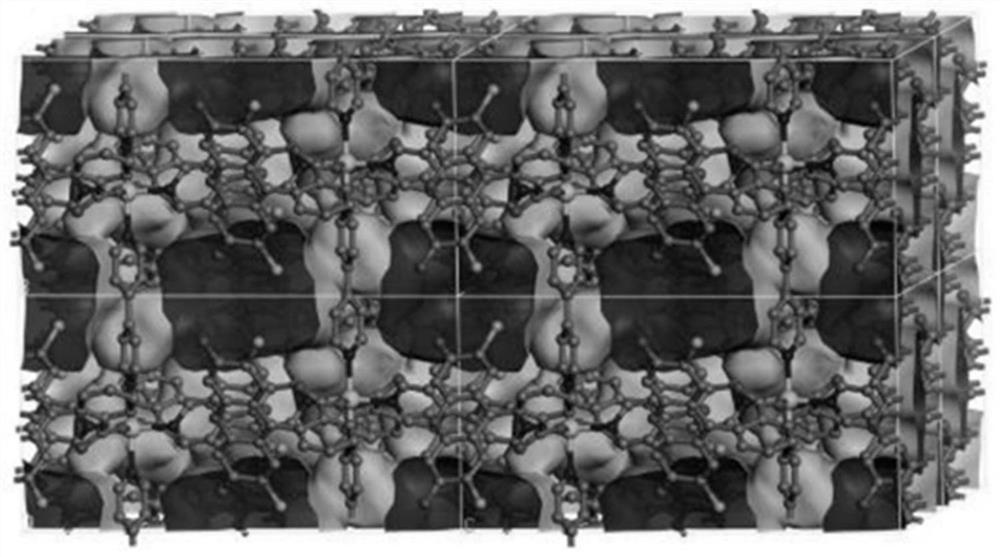Visible light catalyzed styrene bifunctionalization reaction metal-organic framework material as well as preparation method and application thereof
A styrene bifunctional, organic framework technology, applied in the field of photocatalytic materials, can solve the problems of high synthesis cost, low cycle stability, poor utilization of visible light, etc., achieves low cost, easy large-scale preparation, and promotes light induction. Effects of Electron Transfer Process
- Summary
- Abstract
- Description
- Claims
- Application Information
AI Technical Summary
Problems solved by technology
Method used
Image
Examples
Embodiment 1
[0028] A method for preparing a metal-organic framework material that catalyzes the difunctionalization reaction of styrene with visible light, and the specific steps are as follows:
[0029] (1) Weigh 8.2mg 2',7'-dichlorofluorescein (DCF), 6.3mg 4,4'-bipyridine (bpy) and 15mg Co(NO 3 ) 2 ·6H 2 O, placed in a 10mL glass sample bottle, add 4mL of a mixed solvent of water and methanol (1:1 by volume), and stir well.
[0030] Among them, the structural formulas of 2',7'-dichlorofluorescein (DCF) and 4,4'-bipyridine (bpy) are as follows:
[0031]
[0032] (2) Put the glass sample bottle in the hydrothermal synthesis reaction kettle, then place the hydrothermal synthesis reaction kettle in an electric blast drying oven, keep the temperature at 80°C, and react for 24 hours.
[0033] (3) After the reaction is finished, cool down to obtain red blocky crystals, filter, wash, and dry at 100°C for 6 hours to obtain the metal-organic framework material for the visible light-catalyze...
Embodiment 2
[0040] Example 2 Solid UV-visible absorption spectrum test of Co-DCFB
[0041] Weigh 10 mg of the material Co-DCFB in Example 1 and load it as a sample for solid ultraviolet testing. Test results such as image 3As shown, it can be seen that the wide absorption band of Cd-EY in the range of 340-550nm indicates that the material has a response in the visible light range, which provides a prerequisite for improving the utilization rate of visible light and the high efficiency of photocatalysts.
Embodiment 3
[0042] Example 3 Catalytic Performance Test of Co-DCFB on Styrene Difunctionalization Reaction
[0043] To containing styrene (1.0mmol) and NH 4 Add photocatalyst Co-DCFB (2.5μmol) to 3mL acetonitrile solution of SCN (1.2mmol), and irradiate with 2.50W green LED lamp (λ=535nm), the specific reaction formula is as follows:
[0044]
[0045] The resulting mixture was stirred at room temperature for 6 h, and the reaction was monitored by TLC. 1 H-NMR analysis confirmed the yield. The test results are shown in Table 2. It can be seen that the catalyst has good catalytic efficiency whether it is an electron-withdrawing olefinic substrate or an electron-donating olefinic substrate.
[0046] Table 2 Test results
[0047]
[0048]
PUM
 Login to View More
Login to View More Abstract
Description
Claims
Application Information
 Login to View More
Login to View More - R&D
- Intellectual Property
- Life Sciences
- Materials
- Tech Scout
- Unparalleled Data Quality
- Higher Quality Content
- 60% Fewer Hallucinations
Browse by: Latest US Patents, China's latest patents, Technical Efficacy Thesaurus, Application Domain, Technology Topic, Popular Technical Reports.
© 2025 PatSnap. All rights reserved.Legal|Privacy policy|Modern Slavery Act Transparency Statement|Sitemap|About US| Contact US: help@patsnap.com



